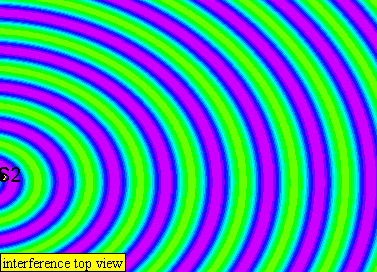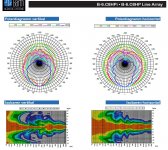I heard Bruno Putzeys' Kii speakers at the recent NYC audio show, and it seems many people there were quite impressed with them. I felt Kii would sound better than the most mainstream near / midfield studio monitors these days.
They are hypex multiple amp driven active speakers with a new technology, Active Focus Filter, which is probably the same concept as Geithain's cardioid bass.
acoustics
Anyone can explain the detail of this technology? I guess it is probably based on some kind of phase-shifted digital delay line involved, and it can be added to any existing speaker system.
They are hypex multiple amp driven active speakers with a new technology, Active Focus Filter, which is probably the same concept as Geithain's cardioid bass.
acoustics
Anyone can explain the detail of this technology? I guess it is probably based on some kind of phase-shifted digital delay line involved, and it can be added to any existing speaker system.
Last edited:
Hi Plasnu,
Kii "Three" works AFAIK as a monopole below approx. 60Hz and as a cardioid from (middle) bass to midrange.
The two side mounted bass drivers change their roles in midrange and are then used for also increasing the directivity of the midrange unit (at least in lower midrange AFAIK).
That "role changing" of the side mounted bass drivers (being "cardioid front drivers" in bass and "rear drivers" in midrange ...) has been supposed by myself in a german forum - where the speaker was presented - and Bruno confirmed that "trick" in a later post.
So there are some differences to the Geithain concept of cardioids, which maintain the cardioid pattern until the "lower end".
Kii "Three" avoids that also for reasons of efficiency and saving "displacement volume" at LF, which is not unlimited with such a rather small speaker to achieve appropriate levels of sound pressure in lower bass.
Also Bruno Putzeys sees no advantage in maintaining the cardioid pattern to the "lower end".
(Which is where our opinions differ, but nevertheless for such a compact speaker - operating fullrange and not necessarily dependent from a subwoofer - he surely made a good decision ...)
Kii "Three" works AFAIK as a monopole below approx. 60Hz and as a cardioid from (middle) bass to midrange.
The two side mounted bass drivers change their roles in midrange and are then used for also increasing the directivity of the midrange unit (at least in lower midrange AFAIK).
That "role changing" of the side mounted bass drivers (being "cardioid front drivers" in bass and "rear drivers" in midrange ...) has been supposed by myself in a german forum - where the speaker was presented - and Bruno confirmed that "trick" in a later post.
So there are some differences to the Geithain concept of cardioids, which maintain the cardioid pattern until the "lower end".
Kii "Three" avoids that also for reasons of efficiency and saving "displacement volume" at LF, which is not unlimited with such a rather small speaker to achieve appropriate levels of sound pressure in lower bass.
Also Bruno Putzeys sees no advantage in maintaining the cardioid pattern to the "lower end".
(Which is where our opinions differ, but nevertheless for such a compact speaker - operating fullrange and not necessarily dependent from a subwoofer - he surely made a good decision ...)
Last edited:
Hi Plasnu,
No. The 4 woofers work in phase at the low end.
In mid and upper bass the 2 side woofers and the 2 rear woofers make up a cardioid.
Common technique is to give a delay to the rear woofers and apply a lowpass filter to cancel the radiation to the rear.
That is commonly used in PA cardioid subwoofers e.g.
Geithein uses a "resistance box" where the rear sound source used for cancellation is made up by a (passive) flow resistor. The delay and low pass filter effect needed in a cardioid is here provided "acustically" by the cabinet's volume (providing mechanical compliance) and the flow resistor.
The principle is first described by Kalusche 1950. Works well and has been also refined over the decades ...
Kii uses active controlled (filtered) woofers, like common in PA nowadays.
No. The 4 woofers work in phase at the low end.
In mid and upper bass the 2 side woofers and the 2 rear woofers make up a cardioid.
Common technique is to give a delay to the rear woofers and apply a lowpass filter to cancel the radiation to the rear.
That is commonly used in PA cardioid subwoofers e.g.
Geithein uses a "resistance box" where the rear sound source used for cancellation is made up by a (passive) flow resistor. The delay and low pass filter effect needed in a cardioid is here provided "acustically" by the cabinet's volume (providing mechanical compliance) and the flow resistor.
The principle is first described by Kalusche 1950. Works well and has been also refined over the decades ...
Kii uses active controlled (filtered) woofers, like common in PA nowadays.
Last edited:
Which is a valuation ... 
From a technical - result oriented - point of view, both approaches work.
It is a bit diffcult to morph a cardiod to a monopole at lower bass.
But i know a company also (not geithain) who does even this by using an acoustical/mechanical device:
Technologie - Barth Acoustic Systems
But i "know what you mean" and i am constructing an refining "classical" cardioids myself:
I can see no drawbacks, in the contrary. But engineering effort may be even higher in the classical approach, as you have to care for details you can neglect when solving the problem using multiple drivers and digital/active filters.
From a technical - result oriented - point of view, both approaches work.
It is a bit diffcult to morph a cardiod to a monopole at lower bass.
But i know a company also (not geithain) who does even this by using an acoustical/mechanical device:
Technologie - Barth Acoustic Systems
But i "know what you mean" and i am constructing an refining "classical" cardioids myself:
I can see no drawbacks, in the contrary. But engineering effort may be even higher in the classical approach, as you have to care for details you can neglect when solving the problem using multiple drivers and digital/active filters.
Last edited:
Barth is monopele in bass, at least this line array http://www.barth-acoustic.com/?dl_name=B-6.C8HP.Rev2.pdf
But look at these instead! http://kimmosaunisto.net/CardSub/CARDSUB.html
But look at these instead! http://kimmosaunisto.net/CardSub/CARDSUB.html
Attachments
Last edited:
Barth is monopele in bass, at least this line array http://www.barth-acoustic.com/?dl_name=B-6.C8HP.Rev2.pdf
...
Hi Juhazi,
that is why i mentioned it with respect to Kii "Three", which is a monopole at the low end too.
It is a bit diffcult to morph a cardiod to a monopole at lower bass.
Maybe replace "morph" by "make a transition from".
I tried cardioid bass in my partially open living room and the results were not much better than monopole bass. The setup consisted of front and rear firing 15" woofers, both EQ'ed to 30hz, and varying amounts of delay added to the rear woofer. It wasn't until I added a pair of dipole 15" woofers to the setup that bass response was flat. IMO, cardioid bass isn't effective for your typical living room.
IMO, cardioid bass isn't effective for your typical living room.
one experiment and now cardioid isnt effective!

Here's the measured response of a clone that someone made here : Der Kii THREE Nachbauthread, Lautsprecher - HIFI-FORUM (Seite 4)
I posted a thread titled "an improved array" this week that has some illustrations of how this works in the Beolab 90
Bump and some questions for the clever guys...
Would it be possible to do something similar with a driver on the back only, delayed and inverted phase, reduced level, to get a cardiod pattern? Are the side drivers in the Kii wired in phase with the front drivers?
Also it seems from online photos that the box does NOT have seperate sections. How is it possible considering the rear units are out of phase with the rest of the drivers? Would they interfere with each other?
Would it be possible to do something similar with a driver on the back only, delayed and inverted phase, reduced level, to get a cardiod pattern? Are the side drivers in the Kii wired in phase with the front drivers?
Also it seems from online photos that the box does NOT have seperate sections. How is it possible considering the rear units are out of phase with the rest of the drivers? Would they interfere with each other?

Here's an animation of an object radiating in 360 degrees, similar to how a speaker in a sealed box behaves.
Now imagine if you put one speaker on each side of the box, four total. And then you varied their amplitude and their delay.
If you had sufficient processing power, you can set things up so that the speakers on the sides and the back were out-of-phase with the speaker on the front.
And THAT is how you build an active cardioid.
You could probably get some cancellation with just a speaker on the back. But if you're a control freak, you're going to put speakers on all four sides.
Check out the Beolab 90, and the Lexicon speaker from Horbach for more ideas on how to do this.

Horbach is a madman, four speakers were not enough!
Last edited:
1. Assuming you have at least one driver at the front of the enclosure and one at the back: no, the spacing between the sources is too large for obtaining a clean cardioid pattern up to the frequency at which the front driver takes over and has its own (baffle and cone diameter related) directivity.1. Would it be possible to do something similar with a driver on the back only, delayed and inverted phase, reduced level, to get a cardiod pattern?
2. Are the side drivers in the Kii wired in phase with the front drivers?
3. Also it seems from online photos that the box does NOT have seperate sections. How is it possible considering the rear units are out of phase with the rest of the drivers? Would they interfere with each other?
2. No, it's more complicated. They have a certain optimized response. At midrange frequencies the side woofers form a cardioid pair together with the (front) midrange driver, at low-mid frequencies they form a cardioid pair with the rear woofers and at low frequencies they form a monopole with the rear woofers. I suppose Kii have used some computer optimisation to calculate the filters.
3. You can correct for this coupling to cancel it. If movement of woofer A compresses the air inside the box and moves woofer B, which is supposed to do nothing, you can send the same signal but modified and inverted to woofer B to cancel its motion.
Last edited:
The complicated bit is making it work over several octaves. As TBTL explained, this why the Kii needs 2 cardioid pairs & places the side woofers nearer the baffle.
OTOH, if you want to play with cardioids, a small pair of speakers & a little DSP are enough to get hands-on experience.
OTOH, if you want to play with cardioids, a small pair of speakers & a little DSP are enough to get hands-on experience.
- Status
- This old topic is closed. If you want to reopen this topic, contact a moderator using the "Report Post" button.
- Home
- Loudspeakers
- Multi-Way
- Bruno Putzeys Kii Speakers' technology
